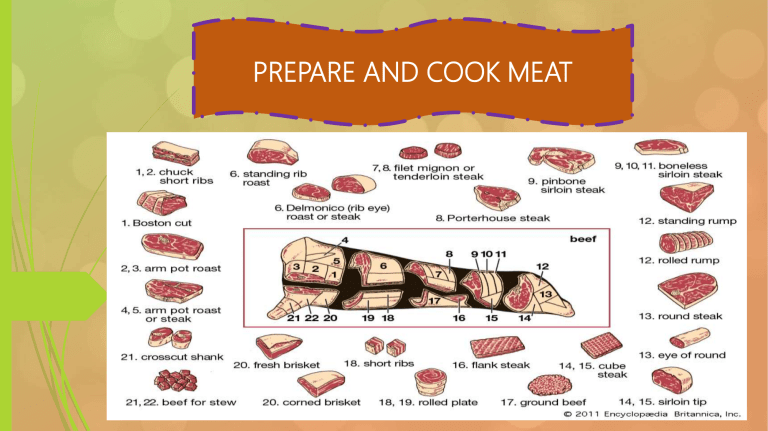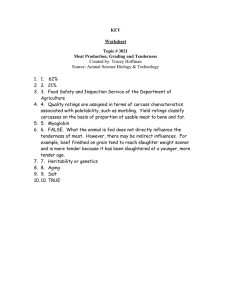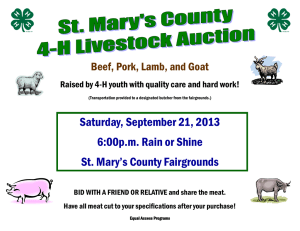
PREPARE AND COOK MEAT TECHNICAL TERMS 1. MIREPOIX – a mixture of chopped celery, onions and carrots. 2. MUTTON – the flesh of a mature sheep used for food. 3. BEBABS – cubes of meat marinated and cooked with vegetables usually on a skewer. 4. SIRLOIN – a cut of meat and especially of beef from the part of the hindquarter just in front of the round. 5. TENDERLOIN – a piece of very tender meat from the back of a cow or pig. 6. ROUX – a cooked mixture of flour and fat used as a thickening agent in a soup or a sauce. 7. SHANK –a cut of meat. 8. HERMETICALLY – completely sealed, especially against the escape or entry of air. DIFFERENT KINDS OF MEAT 1. PORK – comes from young hogs, about four to six months old. It is usually sold by weight and not by age. age. Pork is usually pink but may be darker when comes from old hog. 2. BEEF – comes from mature cattle that are between 15 to 20 months old. Young beef comes from cattle which are 7b to 10 months old with small amount of fat and is less flavorful and juicy than mature beef. 3. CARABEEF OR CARABAO – is considered by many as a healthy food because it is safe to eat even by people with heart problems and those who are allergic to red meat. Carabao meat contains less calories, less fat, and less cholesterol than most meats, including poultry. 4. VEAL – is the meat from calves between four and five months. There are two kinds of veal: one from milk milk fed calves and the other from those fed on grass. Milk fed veal is the tenderest, but grass fed veal has a better flavour. 5. LAMB – is meat from young sheep which is less than a year old. This meat, is tender, flavorful and juicy with a punkish red color. DIFFERENT TYPES OF MEAT CUT 1. BONELESS CUTS – (beef, pork, lamb”) economical and suitable for quick and easy methods of cooking. (ex. Grilling) 2. BORNED AND ROLLED JOINTS OF MEAT – smaller joint to reduce cooking time and making easier to carve. 3. LEAN AND EXTRA LEAN CUTS – trimmed cuts of meat which are lower in fat. 4. CUBES OF MEAT – sold cut into cubes, ready for making stews, kebabs and casseroles. 5. LEAN MINCED MEAT – meat is trimmed of fat and minced. 6. THIN STRIPS – meat is pre-cut into strips, suitable for quick cooking methods. (ex. Stir-frying). MARKET FORMS OF MEAT 1. FRESH MEAT – meat that are sold right after slaughter without undergoing chilling or other preservation method. 2. CHILLED MEAT – meat that has been cooled to a temperature just above freezing point within within 24 hours after slaughter. 3. FROZEN MEAT – meat cuts that has been frozen to a temperature of 20 degree Celsius. 4. CURED MEAT – meat that has been treated with a curing agent or solution. 5. PROCESSED MEAT – canned meat products prepared, frozen, then heat processed hermetically. METHODS OF COOKING MEAT 1. ROASTING – this method is suitable for any tender cut of beef, veal, pork or lamb. To roast, place the meat on a rack in a roasting pan without water. 2. BROILING/GRILLING – this is cooking by direct, radiant heat and is used for smaller, tender cuts such as steaks or chops. 3. BARBEQUING –the method of cooking food by barbequing is usually associated with fund raising activities, parties or picnic. It is most suitable to cooking meat cutlets, fish or chicken pieces. 4. PAN-BROILING – tender cuts of meat that are suitable for oven broiling or grilling can also be pan broiled. It is an excellent method for small, thin cuts of steaks or chops. 5. PAN FRYING – small, tender cuts of meat, especially those that are lean, are good for panfrying. It is similar to pan-broiling but some fat in the form of butter, margarine, oil, or shortening is added. 6. SAUTEING – it is a dry-heat cooking method using high heat and selected for smaller cuts in which heat is conducted by a small amount of fat. 7. BRAISING – also known as pot-roasting, braising is generally used for less tender cuts, although some tender cuts like pork or veal chops can also be tasty when braised. This method involves cooking the meat in a small amount of liquid. 8. BASTING – this method of cooking is usually associated with roasting. The juice or liquid that comes out of the meat being cooked is spooned over the roast frequently while it is being roasted. 9. STEWING – this method is recommended for less tender cuts of meat. It is similar to braising except the meat is covered in liquid and generally cut into small pieces. 10. SIMMERING – it is usually associated with specific tougher cuts of meat that need to be tenderized through long, slow, moist cooking. PREPARING MEAT 1. MARINATING – it is the process of soaking meat in a seasoned liquid to flavour and tenderize it. 2. BARDING – it is the process of covering the surface of meat or poultry with thin slices of pork back fat or bacon and typing them in place butcher’s twine. 3. LARDING – it is the process of inserting small strips of pork fat into meat with a larding needle needle to imitate marbling. 4. JACQUARDING – it is a process of piercing muscle tissue with needles to tenderize. 5. TUMBLING – it is a process in which solid muscles meat is tumbled with crushed ice and/or a seasoned liquid until the meat absorbs a prescribed percentage of its weight in liquid. 6. NEEDLING – it is a process in which a solution is injected into the muscle to provide moisture and flavour. METHODS OF PRESENTING MEAT DISHES 1. Avoid a monochromatic color scheme. 2. Fry foods carefully. 3. Take pains to handle the fried foods gently so they look appetizing when you are ready to plate them. 4. Take texture into account. 5. Choose white plates. Visualize the finished plate. 6. Limit portion sizes. 7. Follow the rule of odds. 8. Play with different textures. 9. Layer foods to add height. 10. Use sauce wisely.


